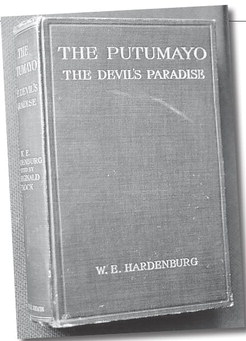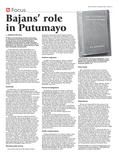Bajans’ role in Putumayo
by GRENVILLE PHILLIPS II IN 1904, the United States started construction on the Panama Canal which was opened in 1914.
During this time at least 45 000 Barbadians travelled to Panama and their wages that were repatriated into Barbados’ economy benefited all Barbadians. Our historians rightly remind us about their remarkable achievements.
At the same time, many Barbadians were also contracted to travel to South America, but their destination was Peru. They were to work in the rubber industry. Between 1904 and 1912, approximately 200 Barbadians who travelled to Peru washed their wages in Barbados’ economy – and tainted all Barbadians. Our historians have not similarly told us about this part of our history.
The industrial revolution required a reliable and adequate supply of fuel, metal and rubber. Rubber was mainly sourced from the rubber trees around the 1.3 kilometre-long Putumayo River in Peru and Columbia, which was one of the tributaries of the Amazon River.
The Putumayo area was inhabited by several docile Indian tribes, the main ones being Huitotos, Borass, Andokes, and Ocainas. There were smaller tribes that included Ricigaros and Muinanes. We should remember those tribes because our fellow Barbadians were mainly employed to hunt and enslave the indigenous Indians, force them to work in the rubber industry, and torture and kill men, women and children who did not collect their quotas of latex.
Genocide
In 1906, there were approximately 50 000 indigenous Indians in the Putumayo district. By 1911 not more than 7 000 could be found. Our fellow citizens participated in perhaps the worst and most investigated genocide ever documented.
The results of an investigation follows: “that they force the Pacific Indians of the Putumayo to work day and night at the extraction of rubber, without the slightest remuneration; that they give them nothing to eat; that they keep them in the most complete nakedness; that they rob them of their crops, their women, and their children to satisfy the voracity, lasciviousness and avarice of themselves and their employees, for they live on the Indians’ food, keep harems and concubines, and sell these people at wholesale and retail in Iquitos; that they flog them inhumanly, until their bones are visible; “that they give them no medical treatment, but let them die, eaten up by maggots, or to serve as food for the [Peruvian] chiefs’ dogs; that they castrate them, cut off their ears, fingers, arms, legs; that they torture them by means of fire, of water, and by tying them up, crucified, head down; that they burn and destroy their houses and crops; that they cut them to pieces with machetes; that they grasp children by the feet and dash their heads against walls and trees, until their brains fly out; “that they have the old folks killed when they can work no longer; and, finally, that to amuse themselves, to practise shooting, or to celebrate the sabado de gloria – as Fonseca and Macedo have done – they discharge their weapons at men, women, and children, or, in preference to this, they douse them with kerosene and set fire to them to enjoy their desperate agony.” ( The Putumayo: The Devil’s Paradise, pages 213-214.)
Working under duress
Casa Arana was one of the largest rubber companies operating in the Putumayo district.
Barbadians were contracted in Barbados to work for Casa Arana, which later became the Peruvian Amazon Company, a company registered in London with three British directors. The ages of the young black Barbadians were generally between 18 and 21 years old. At least five women were also contracted.
When the Barbadians learned about the horrific slaving duties they were expected to perform, many complained to the British Consul in Peru asking for an annulment of their contracts. It was not given and many were forcibly escorted into the lawless and remote interior – to do their terrible crimes against humanity.
Unsilent engineers
In 1905, Peruvian engineer Jorge von Hassel published a report describing the abuse of the Indians. It was ignored. In 1908, American engineer Walter Hardenburg spent one year using his own resources to obtain sworn testimonies from those willing to expose the atrocities. Benjamin Rocca’s testimony reveals the difficult position of our fellow Barbadians.
“They beat, put in stocks, club, and even murder employees who do not do everything the [Peruvian] chiefs order, and what is even worse they teach them to be assassins, to flog, to burn Indians, to mutilate them – that is, to cut off their fingers, arms, ears, legs, [et cetera]. As is evident, it is a horror to go to the Putumayo. I should prefer to go to hell.” ( The Putumayo: The Devil’s Paradise, page 216)
Formal investigations
Hardenburg travelled to London in 1909 and summarised his findings in a news article titled
The Devil’s Paradise. The Peruvian Government categorically denied the allegations. The directors of the Peruvian Amazon Company in London claimed to have no reason to believe them. The Anti-Slavery and Aborigines Protection Society in London took the case and noted that “nothing reported from the Congo has equalled in horror some of the acts alleged against the rubber syndicate”.
In 1910, the British Foreign Office sent British Consul, Roger Casement, who had investigated the atrocities in the Congo, to investigate the Putumayo, with justification that coloured men of Barbados, who were British subjects, may be mistreated.
The directors of the company also sent a Commission to investigate at the same time.
Casement handed in his report in January 1911. In March 1911, the Peruvian government started its own investigation led by judges Romulo Paredes and Carlos Valcárcel. They confirmed Casement’s report with 3 000 pages of testimony detailing accusations of extreme cruelty and murder. Casement’s report was laid in Parliament in July 1912 and became a public document.
Public condemnation
Public condemnation was swift. In August 1912, Canon Henson denounced the English directors of the company by name from the pulpit of Westminster Abbey and demanded their arrest and public trial. The international press also reported on the slavery. However, by that time, it was too late for most of the indigenous Indians, because the genocide was almost complete. In December 1912, Hardenburg published his book: The Putumayo: The Devil’s Paradise. The Peruvian Amazon company was liquidated in 1913.
Dirty hands
Many Barbadian families may be related to the participants in perhaps one of the most well-documented atrocities committed after the abolition of slavery. The surnames of some of the Barbadians listed in Casement’s report follow. This is not a list of all the Barbadians who travelled to Peru, since by the time of Casement’s investigations in 1910, many had returned to Barbados at the end of their two-year contracts.
Archer, Atkins, Batson, Benn, Bishop , Blades, Brown, Cadogan, Chase, Clark, Cox, Crichley, Crichlow, Cumberbatch, Davis, Downes, Downs, Dyall, Ford, Francis, Gibbs, Greenidge, Henry, Hinds, Hoyte, Isaacs, Jacob, Johnson, Jones, Jordan, King, Labadie, Lavine, Lawrence, Layne, Lewis, Mapp, Minggs, Morris, Myers, Percy, Prescott, Quales, Quintyne, Rock, Rollereston, Scandleburg [Scantlebury], Sealey, Smith, Stokes, Stuart, Thompson, Voiss, Walcott, Walker, Walterman, West, Woodroffe, Yarbick, and to my great dismay, Phillips.
Reparations
We are not responsible for the actions of our fellow citizens, and carry no generational guilt.
However, using similar arguments made by those advocating for reparations, since the wages of genocide were mixed in the common Barbadian economy, we all received a benefit. Therefore, no one’s hands are clean – we all owe reparations.
To quantify the debt based on the wages of the Barbadian workers or the value of the latex extracted by the Indians is a high-order insult.
The reparations amount for the enslavements, tortures and murders is astronomical and we can never afford it. We can either try to atone for it by spending an eternity in hell, or this debt can be forgiven. I recommend the latter option. Since the injured parties are dead, forgiveness must be sought from our common Creator.
Once forgiven, the debt is fully paid. However, each Barbadian family may decide what they want to do for the descendants of those whom our fellow citizens were forced to harm – not out of any debt obligation, but as responsible human beings. As for me and my house, I plan to contact those tribes and offer whatever assistance I can. Should the Government receive any reparations from Britain on my behalf, they should send my portion to the surviving Indians along the Putumayo River.
Grenville Phillips II is a doctor of engineering and a chartered structural engineer. This article was submitted as a Letter to the Editor.


